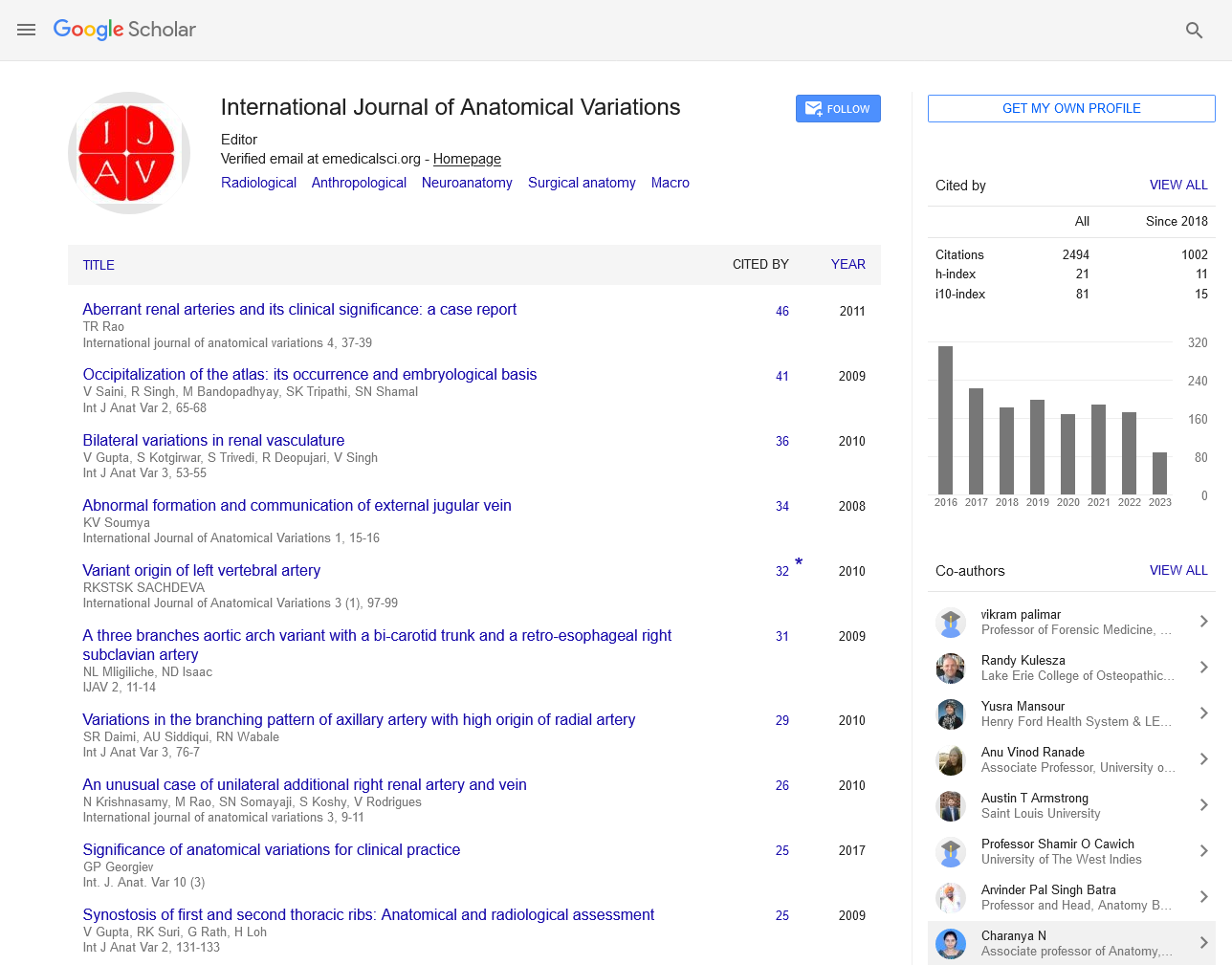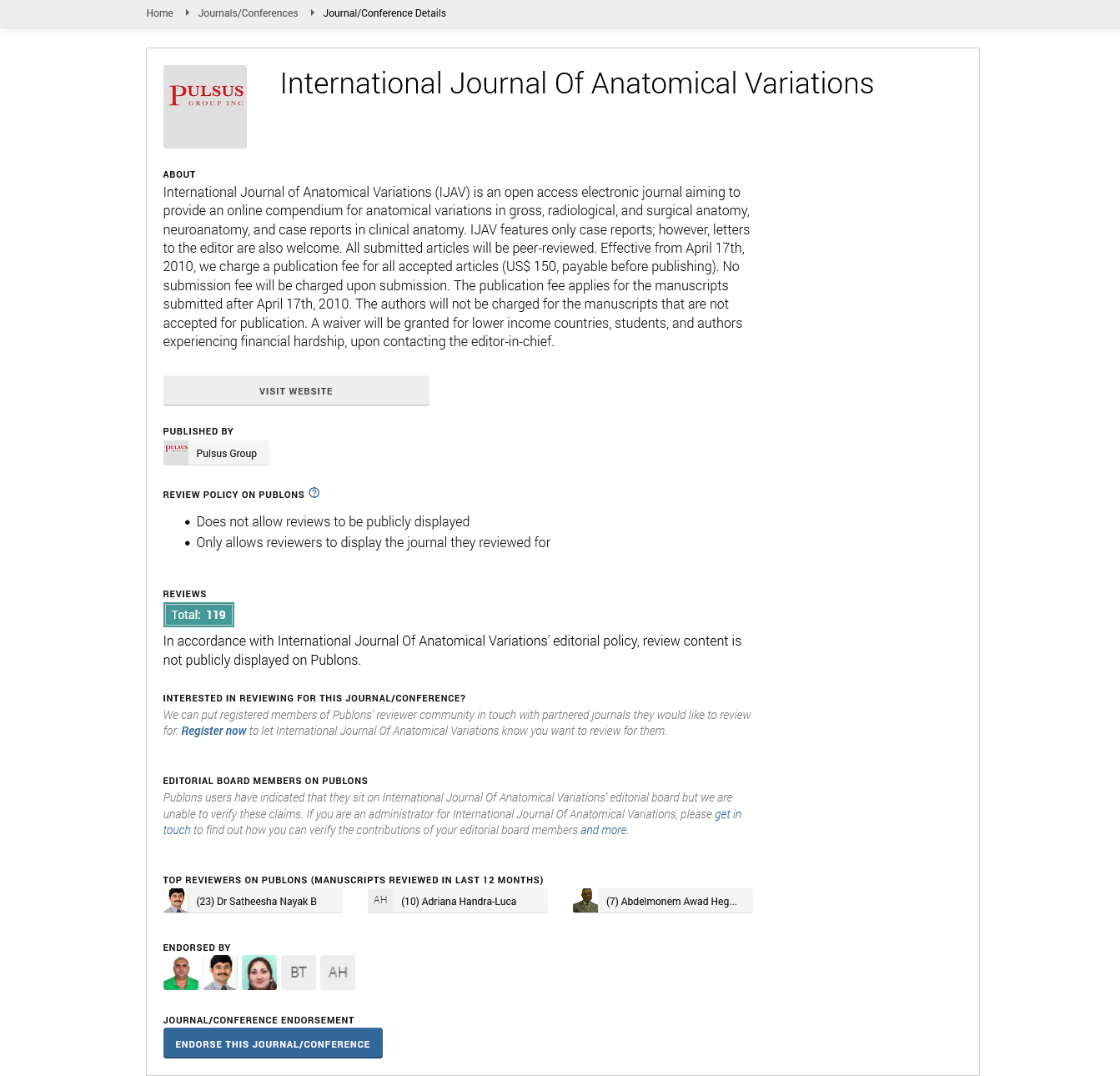Anatomy and Health Understanding the Interconnected Foundation of Human Well-being
Received: 01-Mar-2025, Manuscript No. ijav-25-7635; Editor assigned: 04-Mar-2025, Pre QC No. ijav-25-7635 (PQ); Reviewed: 19-Mar-2025 QC No. ijav-25-7635; Revised: 26-Mar-2025, Manuscript No. ijav-25-7635 (R); Published: 30-Mar-2025, DOI: 10.37532/1308 4038.18(3).493
Citation: Sahu A. Anatomy and Health Understanding the Interconnected Foundation of Human Well-being. Int J Anat Var. 2025; 18(3): 756-757.
This open-access article is distributed under the terms of the Creative Commons Attribution Non-Commercial License (CC BY-NC) (http://creativecommons.org/licenses/by-nc/4.0/), which permits reuse, distribution and reproduction of the article, provided that the original work is properly cited and the reuse is restricted to noncommercial purposes. For commercial reuse, contact reprints@pulsus.com
Abstract
The human body is an intricate system, and anatomy—the study of its structure—is fundamental to understanding health and disease. This article explores the critical relationship between human anatomy and health outcomes, emphasizing how anatomical knowledge underpins clinical practice, informs preventative care, and advances medical research. We delve into key anatomical systems, their roles in maintaining health, and how dysfunction within these systems leads to disease. Through a multidisciplinary lens, we also examine the implications of anatomical education in shaping the future of healthcare.
INTRODUCTION
Anatomy has long served as the cornerstone of medicine and healthcare [1]. From ancient dissections to modern 3D imaging, our understanding of the human body has evolved dramatically. Health, broadly defined as a state of physical, mental, and social well-being, depends intrinsically on the functional integrity of anatomical systems. As such, an integrative approach that links anatomical knowledge with clinical outcomes is vital. This paper aims to explore how anatomy not only supports physiological function but also influences disease prevention, diagnosis, and treatment [2].
THE ROLE OF ANATOMY IN UNDERSTANDING HEALTH
Anatomy provides the basic blueprint of the human body. It reveals how organs are arranged, how systems interconnect, and how structure determines function. For instance, the musculoskeletal system allows for movement and support; disruptions such as scoliosis or osteoporosis can severely impair mobility and overall health. Similarly, cardiovascular anatomy is pivotal for oxygen and nutrient distribution—a blocked artery can lead to myocardial infarction or stroke [3].
FUNCTIONAL ANATOMY AND PHYSIOLOGY
While anatomy describes "what" is present, physiology explains "how" it works. Together, they provide a comprehensive understanding of health. For example, the nephron’s anatomical complexity in the kidney enables precise filtration of blood, essential for fluid and electrolyte balance. Dysfunctional renal anatomy often correlates with hypertension or chronic kidney disease [4].
ANATOMICAL VARIATIONS AND PERSONALIZED MEDICINE
Not every human body is identical. Variations in anatomical structures can influence susceptibility to certain conditions or responses to treatments. Recognizing these differences is central to personalized medicine. For instance, anatomical variations in coronary arteries can affect the outcomes of bypass surgeries or stenting procedures [5].
CLINICAL APPLICATIONS OF ANATOMICAL KNOWLEDGE
Modern diagnostic tools like MRI, CT scans, and ultrasound rely on anatomical understanding for interpretation. Anomalies such as tumors, cysts, or lesions are identified and located using this foundational knowledge. In oncology, precise anatomical mapping helps in tumor staging and treatment planning. Surgical practice is entirely dependent on anatomical accuracy. A neurosurgeon navigating the brain’s intricate vasculature or an orthopedic surgeon repairing a torn ligament must rely on detailed anatomical maps. Errors in anatomical judgment can lead to life-threatening complications. Educating patients about their own anatomy can lead to better health outcomes. Understanding how the lungs function can help patients with asthma or COPD manage their condition more effectively. Similarly, awareness of reproductive anatomy is vital for sexual health and contraception.
PREVENTIVE SCREENING
Anatomical screening tools like colonoscopy, mammography, and Pap smears are essential in early disease detection. By identifying precancerous or pathological changes in structure, these tools enable timely intervention and significantly improve prognosis.
ERGONOMICS AND MUSCULOSKELETAL HEALTH
Workplace ergonomics, which depend on anatomical principles, can prevent musculoskeletal disorders. Proper chair design, keyboard placement, and posture training are informed by anatomical understanding and contribute to long-term physical health.
DIGITAL ANATOMY AND SIMULATION
The advent of digital tools, including virtual dissection and augmented reality, has revolutionized anatomical education. These tools enhance learning outcomes, improve surgical planning, and reduce dependency on cadavers.
3D PRINTING AND BIOMEDICAL ENGINEERING
3D printing of anatomical structures, such as prosthetic limbs or organ models, is transforming personalized healthcare. These innovations rely on detailed anatomical data and promise to redefine surgical precision and patient rehabilitation.
CONCLUSION
Anatomy is not just the study of structure—it is the foundation upon which modern medicine is built. Its relevance permeates every aspect of health, from diagnosis to treatment, education to innovation. As healthcare becomes increasingly personalized and technology-driven, anatomical knowledge will remain central to improving health outcomes and advancing medical science. Ongoing research and integration of new technologies will continue to elevate the role of anatomy in promoting human well-being.
REFERENCES
- Mujagic S, Kozic D, Huseinagic H, Smajlovic D. Symmetry, asymmetry and hypoplasia of intracranial internal carotid artery on magnetic resonance angiography. Acta Med Acad. 2016; 45:1- 9.
- Rusu MC, Vrapclu AD, Lazar M. A rare variant of accessory cerebral artery. Surg Radiol Anat. 2023; 45(5):523-526.
- Krause DA, Youdas JW. Bilateral presence of a variant subscapularis muscle. Int J Anat Var. 2017; 10(4):79-80.
- Mann MR, Plutecki D, Janda P, Pękala J, Malinowski K, et al. The subscapularis muscle‐a meta‐analysis of its variations, prevalence, and anatomy. Clin Anat. 2023; 36(3):527-541.
- Pillay M, Jacob SM. Bilateral presence of axillary arch muscle passing through the posterior cord of the brachial plexus. Int. J. Morphol., 27(4):1047-1050, 2009.
Indexed at, Google Scholar, Crossref
Indexed at, Google Scholar, Crossref
Indexed at, Google Scholar, Crossref






